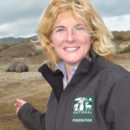We have much more to do and your continued support is needed now more than ever.
How the residents of Chula Vista are changing the world, one Certified Wildlife Habitat at a time

One of my first duties as the new California Director for the National Wildlife Federation was to present the official certification to the City of Chula Vista for achieving the status of Community Wildlife Habitat.
I needed no better reminder of why I took the role with NWF then the passion and enthusiasm of the dozens of people who attended the celebration at the city council meeting where Chula Vista became the 53rd community in the country and the third in the state of California to become a National Wildlife Federation certified Community Wildlife Habitat. The city of 243,000 residents in San Diego County is also the second largest to become certified in the nation, behind only Austin in population size.
After I presented awards in front of the council and Mayor Cheryl Cox, Michelle Castagnola, who led the certification team for the city, organized a small party outside city hall. I enjoyed talking with members of several key community and government groups, such as the Chula Vista Garden Club, the Sweetwater Authority and Otay Water Districts, and Eastlake HOA—all who helped with the certification process. Many brought photos of their backyard habitats and all told wonderful stories about how they became involved.
Pat Alfaro, one of the community members who worked on the Eastlake HOA project as part of the certification, attended the ceremony and spoke about how she became interested. “When I first visited the drought tolerant, wildlife sustaining garden of landscape designer Linda Whitney, I knew that I wanted one for our home. After we had our garden installed, I was a very happy homeowner because the garden gave me such pleasure and serenity. Now every time I drive down Otay Lakes Road and check out our hill, I smile and get such a feeling of accomplishment from helping create a habitat for birds, bees, butterflies and other small creatures. We did a great thing for ourselves, our community and the local wildlife.”
Overall, an impressive 303 homes, 10 schools, 2 nature centers, 5 parks, 4 businesses, a botanical garden, recreation center, civic center, condominium’s grounds and the municipal golf course all achieved National Wildlife Certified Habitat status in Chula Vista.
 The National Wildlife Federation’s Community Wildlife Habitat project is part of NWF’s Certified Wildlife Habitat® program. These projects benefit the entire community of plants, wildlife, and people through the creation of sustainable landscapes that require little or no pesticides, fertilizers, and excess watering. These landscapes help keep water and air resources clean. They are healthier for people and the environment, and are less resource-dependent than conventional landscapes. Habitat landscapes can serve to beautify our urban areas and give residents pride in their neighborhoods. A Community Wildlife Habitat project multiplies this positive effect by creating numerous habitat areas in backyards, schoolyards, corporate properties, community gardens, parkland and other spaces.
The National Wildlife Federation’s Community Wildlife Habitat project is part of NWF’s Certified Wildlife Habitat® program. These projects benefit the entire community of plants, wildlife, and people through the creation of sustainable landscapes that require little or no pesticides, fertilizers, and excess watering. These landscapes help keep water and air resources clean. They are healthier for people and the environment, and are less resource-dependent than conventional landscapes. Habitat landscapes can serve to beautify our urban areas and give residents pride in their neighborhoods. A Community Wildlife Habitat project multiplies this positive effect by creating numerous habitat areas in backyards, schoolyards, corporate properties, community gardens, parkland and other spaces.
Since 1973, NWF has provided millions of people with the basic guidelines for making their landscapes more wildlife-friendly. There are over 138,000 certified habitats nationwide, 9,721 in California and 1,835 in San Diego County.
“Never doubt that a small group of thoughtful, committed citizens can change the world,” said Margaret Mead, and in the city of Chula Vista a group of dedicated citizens helped to change the world for the better by making their city a place where people and wildlife can flourish together.





















